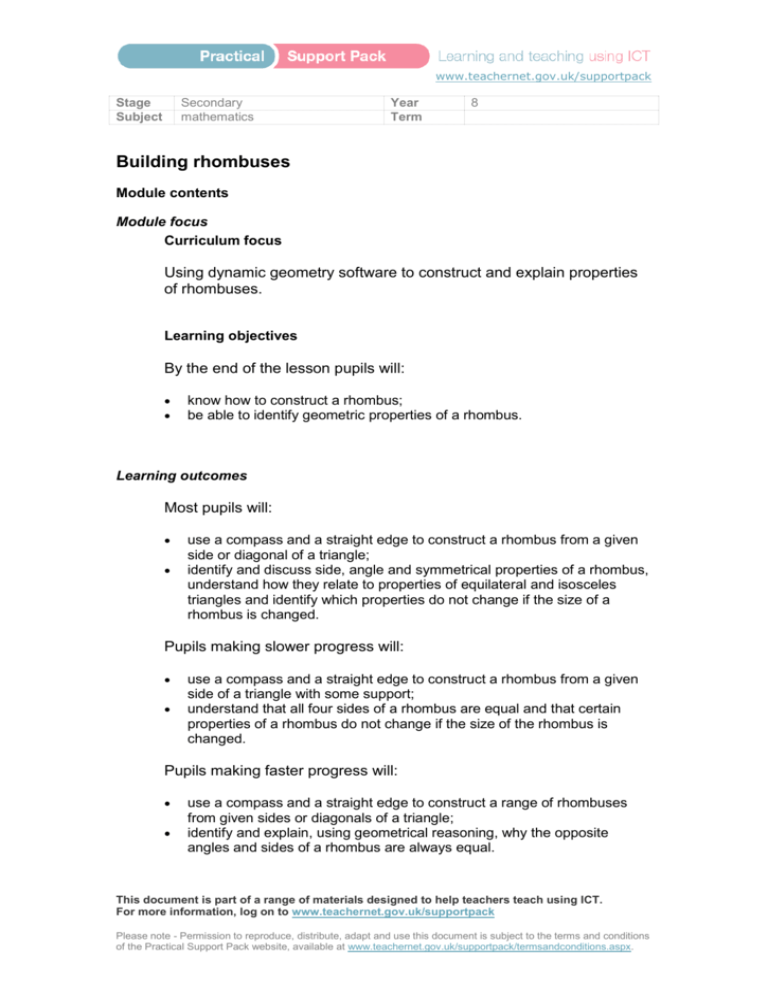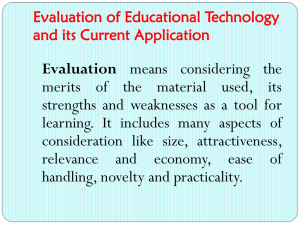Building rhombuses - Secondary Maths ITE
advertisement

www.teachernet.gov.uk/supportpack Stage Subject Secondary mathematics Year Term 8 Building rhombuses Module contents Module focus Curriculum focus Using dynamic geometry software to construct and explain properties of rhombuses. Learning objectives By the end of the lesson pupils will: know how to construct a rhombus; be able to identify geometric properties of a rhombus. Learning outcomes Most pupils will: use a compass and a straight edge to construct a rhombus from a given side or diagonal of a triangle; identify and discuss side, angle and symmetrical properties of a rhombus, understand how they relate to properties of equilateral and isosceles triangles and identify which properties do not change if the size of a rhombus is changed. Pupils making slower progress will: use a compass and a straight edge to construct a rhombus from a given side of a triangle with some support; understand that all four sides of a rhombus are equal and that certain properties of a rhombus do not change if the size of the rhombus is changed. Pupils making faster progress will: use a compass and a straight edge to construct a range of rhombuses from given sides or diagonals of a triangle; identify and explain, using geometrical reasoning, why the opposite angles and sides of a rhombus are always equal. This document is part of a range of materials designed to help teachers teach using ICT. For more information, log on to www.teachernet.gov.uk/supportpack Please note - Permission to reproduce, distribute, adapt and use this document is subject to the terms and conditions of the Practical Support Pack website, available at www.teachernet.gov.uk/supportpack/termsandconditions.aspx. www.teachernet.gov.uk/supportpack References Strategy Framework references Shape, space and measures Geometrical reasoning: lines, angles and shapes Solve geometrical problems using side and angle properties of equilateral, isosceles and right-angled triangles and special quadrilaterals, explaining reasoning with diagrams and text; classify quadrilaterals by their geometric properties Construction and loci Use straight edge and compasses to construct: – the mid-point and perpendicular bisector of a line segment; – the bisector of an angle; – the perpendicular from a point to a line; – the perpendicular from a point on a line; construct a triangle, given three sides (SSS); use ICT to explore these constructions. The Framework for teaching mathematics can be found at: www.standards.dfes.gov.uk/keystage3/respub/mathsframework/forewo rd/. National Curriculum references Ma3 Shape, space and measures Properties of triangles and other rectilinear shapes Pupils should be taught to: d use angle properties of equilateral, isosceles and right-angled triangles; understand congruence, recognising when two triangles are congruent; explain why the angle sum of any quadrilateral is 360 degrees f recall the essential properties of special types of quadrilateral, including square, rectangle, parallelogram, trapezium and rhombus; classify quadrilaterals by their geometric properties This document is part of a range of materials designed to help teachers teach using ICT. For more information, log on to www.teachernet.gov.uk/supportpack Please note - Permission to reproduce, distribute, adapt and use this document is subject to the terms and conditions of the Practical Support Pack website, available at www.teachernet.gov.uk/supportpack/termsandconditions.aspx. www.teachernet.gov.uk/supportpack The National Curriculum programme of study can be found at: www.nc.uk.net/nc/contents/Ma-3-2-POS.html. Use of ICT Teacher use of ICT This module will give you the opportunity to: use dynamic geometry software and a whole-class display to demonstrate how to solve geometrical problems. Requirements Hardware A computer Data projector, large display screen or interactive whiteboard (IWB) Software Dynamic geometry software, such as The Geometer's Sketchpad or Cabri Geometry Word-processing software, such as Microsoft Word Other Compasses, a straight edge, pencils and A3 paper A3 photocopies (for each pupil) of Complete the rhombus task sheets A selection of rhombus shapes cut from coloured card or a product such as Geostrips You can download the viewers needed for these files on the Software downloads page. Lesson preparation A key element of this module is a lesson for you to adopt and adapt to meet the needs of your class. It is designed to help you evaluate the impact of using ICT for learning and teaching. Display and discuss the objectives and key vocabulary for this lesson with the pupils. This document is part of a range of materials designed to help teachers teach using ICT. For more information, log on to www.teachernet.gov.uk/supportpack Please note - Permission to reproduce, distribute, adapt and use this document is subject to the terms and conditions of the Practical Support Pack website, available at www.teachernet.gov.uk/supportpack/termsandconditions.aspx. www.teachernet.gov.uk/supportpack Make sure the equipment is set up prior to the lesson, taking into account strong light sources and potential obstructions. You will need clear access to the screen so that pupils can approach the device and point to specific images. Ensure that the software needed for the lesson is loaded onto your computer or laptop and that the resources Rhombus properties and Constructing rhombuses are accessible. These resources have been provided in two different formats, a Geometer's Sketchpad version and a Cabri Geometry version. Read the lesson plan and familiarise yourself with the resources before the lesson. During the starter activity, you will be asking the pupils to focus on the two triangles ABC and XYZ. As you show the geometric images you will be asking the pupils to discuss the shapes displayed. Ensure that you are aware of the answers you would like to draw out of the pupils, so that you can support them during the starter activity questions. Pupils will be working in pairs to start with, so consider how best to partner pupils and arrange seating so that the whole class can see the screen or whiteboard clearly. It is important to make sure that you have enough compasses, pencils, straight edges, copies of Complete the rhombus enlarged to A3 paper for the main learning activity and a selection of rhombuses cut out from coloured card. Vocabulary bisect, bisector, congruent, construction lines, equilateral, isosceles triangles, parallelogram, perpendicular, radius, rhombus Health & Safety All standard safety procedures with computers need to be in place. Information can be found at www.ictadvice.org.uk. ICT skills guidance The guidance in this section supports the ICT skills described in the Module contents. Pupils' prior knowledge and skills Pupils should already: This document is part of a range of materials designed to help teachers teach using ICT. For more information, log on to www.teachernet.gov.uk/supportpack Please note - Permission to reproduce, distribute, adapt and use this document is subject to the terms and conditions of the Practical Support Pack website, available at www.teachernet.gov.uk/supportpack/termsandconditions.aspx. www.teachernet.gov.uk/supportpack be able to identify and use angle, side and symmetry properties of triangles and quadrilaterals; understand how to solve basic geometrical problems; be able to use a ruler and protractor to measure and draw lines to the nearest millimetre and angles, including reflex angles, to the nearest degree; be able to construct a triangle given two sides and the included angle (SAS) or two angles and the included side (ASA). Starter Open the resource Rhombus properties and display it on the board. Ask pupils to focus on the two triangles ABC and XYZ and invite the class in pairs to talk about what they see. The discussion can be prompted with questions like: What type of triangles are displayed on the screen? What specific properties does an equilateral triangle have? What are the properties of an isosceles triangle? What do both triangles have in common? Ask pupils to look at the entire rhombus (change the line style to bold or solid to make it clearer). Invite a pupil to use the mouse, or, if you are using an interactive whiteboard, the pen or their finger, to drag the point B and ask the class to say what is changing and what is staying the same. Explore the effect of dragging the points A and B. Clarify that even though the shape is changing, the object is always a rhombus. As the triangle ABC is an equilateral triangle, the rhombus has interior angles of 60°, 120º, 60ºand 120º with four equal sides. Ask another pupil to demonstrate on the interactive whiteboard. Ask the pupil to drag the point X on the second shape and, again, ask the pupils to consider what has changed and what is constant (the whole shape changes size but continues to be a rhombus). However, although the side lengths are always equal, the angles can vary in the second construction. Explain to the class that this lesson will help pupils to understand the key properties of the rhombus, by exploring how the sides are always of equal length. This document is part of a range of materials designed to help teachers teach using ICT. For more information, log on to www.teachernet.gov.uk/supportpack Please note - Permission to reproduce, distribute, adapt and use this document is subject to the terms and conditions of the Practical Support Pack website, available at www.teachernet.gov.uk/supportpack/termsandconditions.aspx. www.teachernet.gov.uk/supportpack Main Pupils now work individually, or in pairs, with practical equipment and A3 paper. Distribute the equipment and, using only a pencil, straight edge and compass, ask pupils to construct an equilateral triangle on A3 paper, starting from a straight line using circles (not arcs). Encourage pupils to make their triangle fill half of the A3 page, with all the circles fitting on the paper. Visit each table to make sure that pupils are on task. When the class have done this, discuss some of the different approaches used by the pupils and how they reached their outcomes. At the end of this discussion, remind pupils that a pair of compasses is a tool that fixes a distance, enabling circles to be constructed with the same radius. This is useful to remember when creating a rhombus. Open the dynamic geometry file Constructing rhombuses and complete the rhombus by marking the second point of intersection of the circles and joining the remaining points with line segments. Invite pupils to alter the appearance of the rhombus by changing the length of the measuring stick on the page, or by changing the length of the line segment on which it has been constructed. Use the line segment tool to draw the second diagonal of the rhombus and hide the construction circles. Ask pupils to look carefully at the diagonals of the rhombus (consider changing the colour of them to make them more prominent). Give out the A3 copies of the resource Complete the rhombus. Ask pupils to complete the partially drawn rhombuses, using their compasses and a straight edge. Encourage them to discuss strategies and the resulting similarities and differences between the rhombuses produced by the class. Depending on the length of your lesson, you may choose to display a copy of the Complete the rhombus task sheet onto the interactive whiteboard and invite different members of your class to demonstrate how they completed one of the diagrams on their task sheet. Plenary Hold up one of the rhombuses constructed from the coloured card or a product such as Geostrips. Alter the angle of the shapes and ask pupils what are the key features of a rhombus that do not change. Use rhombuses of different sizes. This document is part of a range of materials designed to help teachers teach using ICT. For more information, log on to www.teachernet.gov.uk/supportpack Please note - Permission to reproduce, distribute, adapt and use this document is subject to the terms and conditions of the Practical Support Pack website, available at www.teachernet.gov.uk/supportpack/termsandconditions.aspx. www.teachernet.gov.uk/supportpack Clarify that the diagonals of the rhombus always intersect at their midpoints and that they are always perpendicular to each other. Ask pupils if there are any other quadrilaterals that have this property (e.g. squares). Give pupils the side length of a rhombus, for example 8cm and ask them to use their compasses and rulers to draw a rhombus. Further informal assessment of your pupils' learning can be done with openended questions, such as: Why are the rhombuses all different? What further information would you need to draw congruent rhombuses? Assessment In assessing for learning you should consider the following points. 1. Ensure objectives are expressed in language that pupils understand. 2. Give pupils clear success criteria related to these objectives. 3. Give pupils opportunities to discuss their successes and challenges focusing on the objectives. 4. Provide oral and written feedback to pupils. 5. Encourage pupils to explain their thinking and reasoning in a secure environment. 6. Provide time for pupils to reflect upon what they have learned and understood and identify any difficulties. You can find information on assessment for learning at: www.standards.dfes.gov.uk/keystage3/respub/afl_ws. Adaptation Pupils making faster progress could be asked more in depth questions such as: Can you use geometrical reasoning to prove that the opposite angles of a rhombus are equal? Pupils could be paired up to produce a written explanation of their answers. They could include the points that all sides of a rhombus are equal and both diagonals are lines of symmetry, leading to a shape with four congruent right angled triangles. Pupils making slower progress may benefit from exploring some paper cut-outs of rhombuses and exploring their lines of symmetry, measuring lines and angles to make inferences. The additional Geometer's Sketchpad resource file Dynamic rhombus gives pupils This document is part of a range of materials designed to help teachers teach using ICT. For more information, log on to www.teachernet.gov.uk/supportpack Please note - Permission to reproduce, distribute, adapt and use this document is subject to the terms and conditions of the Practical Support Pack website, available at www.teachernet.gov.uk/supportpack/termsandconditions.aspx. www.teachernet.gov.uk/supportpack the opportunity to explore the geometric features of the rhombus. They can use the software to measure the side lengths and angles and explore the symmetry of the shape. Ask questions such as: What are the special properties of a rhombus? What similarities and differences does a rhombus have when compared to a square? Evaluation Lesson reflection These prompts are designed to help you reflect on how the use of ICT affected your teaching and pupils’ learning. Prompts for reflection: 1. How did the use of ICT: o help pupils to make better progress towards achieving the learning objectives? o affect the pace of learning? o affect pupils’ motivation, interest and time spent on task? o affect your ability to differentiate your teaching and personalise pupils’ learning? 2. What knowledge or skills have you gained and extended in teaching this lesson? 3. What adaptations would you make to the lesson and its resources to suit the needs of your class? You may wish to create a record of your evaluation and save it as evidence of your professional development. If so, you can download a template containing these prompts and spaces for your responses. Materials evaluation These prompts are designed to help you consider why, how and when you would incorporate these lesson activities and resources into your curriculum and teaching plans. Prompts for evaluation: This document is part of a range of materials designed to help teachers teach using ICT. For more information, log on to www.teachernet.gov.uk/supportpack Please note - Permission to reproduce, distribute, adapt and use this document is subject to the terms and conditions of the Practical Support Pack website, available at www.teachernet.gov.uk/supportpack/termsandconditions.aspx. www.teachernet.gov.uk/supportpack 1. What are the benefits of using these teaching and learning approaches and resources to achieve the subject objectives? 2. How do the suggested activities fit with your existing curriculum and teaching plans? 3. What adaptations would be required to the activities or resources to suit the needs of your class? 4. Are there any requirements for ICT equipment, other resources, space, etc. that might limit how and where the lesson is taught? You may wish to make a note of your thinking for your own records and to share with your colleagues. If so, you can download a template containing these prompts and spaces for your notes. Download module Download module You can download a module pack containing the lesson plan, resources, supplementary information and extension activities using the link below. The pack is in a zipped file to minimise file size, but unless you have a broadband connection, the download may be slow. To extract the files within the module pack you will need either Winzip or Microsoft Windows Extraction Wizard. This software is freely available and can be downloaded from the Software downloads page. This document is part of a range of materials designed to help teachers teach using ICT. For more information, log on to www.teachernet.gov.uk/supportpack Please note - Permission to reproduce, distribute, adapt and use this document is subject to the terms and conditions of the Practical Support Pack website, available at www.teachernet.gov.uk/supportpack/termsandconditions.aspx.

![afl_mat[1]](http://s2.studylib.net/store/data/005387843_1-8371eaaba182de7da429cb4369cd28fc-300x300.png)





